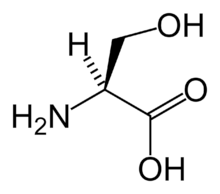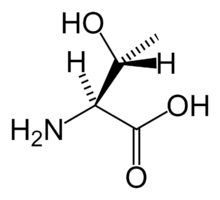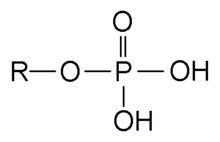
serine

threonine

phosphate
A serine/threonine protein kinase (EC 2.7.11.1) is a kinase enzyme that phosphorylates the OH group of serine or threonine (which have similar sidechains). At least 125 of the 500+ human protein kinases are serine/threonine kinases (STK).[2]
Regulation
Serine/Threonine Kinase receptors plays a role in the regulation of cell proliferation, programmed cell death (apoptosis), cell differentiation, and embryonic development.
Selectivity
While serine/threonine kinases all phosphorylate serine or threonine residues in their substrates, they select specific residues to phosphorylate on the basis of residues that flank the phosphoacceptor site, which together comprise the consensus sequence. Since the consensus sequence residues of a target substrate only make contact with several key amino acids within the catalytic cleft of the kinase (usually through hydrophobic forces and ionic bonds), a kinase is usually not specific to a single substrate, but instead can phosphorylate a whole "substrate family" which share common recognition sequences. While the catalytic domain of these kinases is highly conserved, the sequence variation that is observed in the kinome (the subset of genes in the genome that encode kinases) provides for recognition of distinct substrates. Most kinases are inhibited by a pseudosubstrate that binds to the kinase like a real substrate but lacks the amino acid to be phosphorylated. When the pseudosubstrate is removed, the kinase can perform its normal function.
EC numbers
Many serine/threonine protein kinases do not have their own individual EC numbers and use "2.7.11.1". These were formerly included in EC number "2.7.1.37", which was a general EC number for any enzyme that phosphorylates proteins while converting ATP to ADP (i.e., ATP:protein phosphotransferases.)
Types
Types include those acting directly as receptors (Receptor protein serine/threonine kinase) and Intracellular signaling peptides and proteins. Of the latter, types include:
| EC number |
Name |
Description |
| EC 2.7.11.1 |
CK2, also known by the misnomer casein kinase 2 | was discovered in 1954 by Burnett and Kennedy. |
| EC 2.7.11.1 |
Protein kinase A | consists of two domains, a small domain with several β sheet structures and a larger domain containing several α helices. The binding sites for substrate and ATP are located in the catalytic cleft between the domains (or lobes). When ATP and substrate bind, the two lobes rotate so that the terminal phosphate group of the ATP and the target amino acid of the substrate move into the correct positions for the catalytic reaction to take place. |
| EC 2.7.11.1 |
Protein kinase C ('PKC') | is actually a family of protein kinases consisting of ~10 isozymes. They are divided into three subfamilies: conventional (or classical), novel, and atypical based on their second messenger requirements. |
| EC 2.7.11.1 |
Mos/Raf kinases | form part of the MAPKK Kinase family and are activated by growth factors. The enzyme functions to stimulate growth of cells. Raf inhibition has become the target for new anti-metastatic cancer drugs as they inhibit the MAPK cascade and reduce cell proliferation. |
| EC 2.7.11.1 |
Mitogen-activated protein kinases (MAPKs) | respond to extracellular stimuli (mitogens) and regulate various cellular activities, such as gene expression, mitosis, differentiation, and cell survival/apoptosis. |
| EC 2.7.11.17 |
Ca2+/calmodulin-dependent protein kinases or CaM kinases | are primarily regulated by the Ca2+/calmodulin complex. |
| EC 2.7.11.19 |
Phosphorylase kinase | was in fact, the first Ser/Thr protein kinase to be discovered (in 1959 by Krebs et al.). |
| EC 2.7.1.37 |
Protein Kinase B, also known as AKT kinase | The v-akt gene was identified as the oncogene of retrovirus AKT8. The gene codes for a protein kinase. Human homologs of the AKT8 oncogenic protein were identified in 1987.By 1995 it had been found that Akt kinases function as mitogen-activated kinases downstream from cell surface receptors that activate phosphoinositide 3-kinase. Three human akt genes exist. All three Akt kinases regulate cell proliferation and Akt2 is particularly important for insulin actions in cells. A major target of Akt kinases is glycogen synthase kinase-3. |
| EC 2.7.1.37 |
Pelle | is a serine/threonine kinase that can phosphorylate itself, and also Tube and Toll. |
Clinical significance
Serine/threonine kinase (STK) expression is altered in many types of cancer.[2]
Serine/threonine protein kinase p90-kDa ribosomal S6 kinase (RSK) is in involved in development of some prostate cancers.[3]
Raf inhibition has become the target for new anti-metastatic cancer drugs as they inhibit the MAPK cascade and reduce cell proliferation.
References
- ↑ Nowakowski, J.; Cronin, C. N.; McRee, D. E.; Knuth, M. W.; Nelson, C. G.; Pavletich, N. P.; Rogers, J.; Sang, B. C.; Scheibe, D. N.; Swanson, R. V.; Thompson, D. A. (2002). "Structures of the cancer-related Aurora-A, FAK, and EphA2 protein kinases from nanovolume crystallography". Structure (London, England : 1993) 10 (12): 1659–1667. doi:10.1016/S0969-2126(02)00907-3. PMID 12467573.
- ↑ 2.0 2.1 http://cancerres.aacrjournals.org/cgi/content/full/66/16/8147 "Frequent Alterations in the Expression of Serine/Threonine Kinases in Human Cancers" Capra et al. Cancer Research. 2006
- ↑ http://cancerres.aacrjournals.org/cgi/content/abstract/65/8/3108 "The Serine/Threonine Protein Kinase, p90 Ribosomal S6 Kinase, Is an Important Regulator of Prostate Cancer Cell Proliferation" Cancer Research. 2005
External links
Transferases: phosphorus-containing groups (EC 2.7) |
|---|
| 2.7.1-2.7.4:
phosphotransferase/kinase
(PO4) |
| 2.7.1: OH acceptor |
- Hexo-
- Gluco-
- Fructo-
- Galacto-
- Phosphofructo-
- 1
- Liver
- Muscle
- Platelet
- 2
- Riboflavin
- Shikimate
- Thymidine
- NAD+
- Glycerol
- Pantothenate
- Mevalonate
- Pyruvate
- Deoxycytidine
- PFP
- Diacylglycerol
- Phosphoinositide 3
- Class I PI 3
- Class II PI 3
- Sphingosine
- Glucose-1,6-bisphosphate synthase
|
|---|
| | 2.7.2: COOH acceptor |
- Phosphoglycerate
- Aspartate
|
|---|
| | 2.7.3: N acceptor | |
|---|
| | 2.7.4: PO4 acceptor |
- Phosphomevalonate
- Adenylate
- Nucleoside-diphosphate
- Uridylate
- Guanylate
- Thiamine-diphosphate
|
|---|
|
|---|
| 2.7.6: diphosphotransferase
(P2O7) |
- Ribose-phosphate diphosphokinase
- Thiamine diphosphokinase
|
|---|
| 2.7.7: nucleotidyltransferase
(PO4-nucleoside) |
| Polymerase |
| DNA polymerase |
- DNA-directed DNA polymerase
- I
- II
- III
- IV
- V
- RNA-directed DNA polymerase
- Reverse transcriptase
- Telomerase
- DNA nucleotidylexotransferase/Terminal deoxynucleotidyl transferase
|
|---|
| | RNA nucleotidyltransferase |
- RNA polymerase/DNA-directed RNA polymerase
- RNA polymerase I
- RNA polymerase II
- RNA polymerase III
- RNA polymerase IV
- Primase
- RNA-dependent RNA polymerase
- PNPase
|
|---|
|
|---|
| Phosphorolytic
3' to 5' exoribonuclease | |
|---|
| | Uridylyltransferase |
- Glucose-1-phosphate uridylyltransferase
- Galactose-1-phosphate uridylyltransferase
|
|---|
| | Guanylyltransferase | |
|---|
| | Other |
- Recombinase (Integrase)
- Transposase
|
|---|
|
|---|
| | 2.7.8: miscellaneous |
| Phosphatidyltransferases |
- CDP-diacylglycerol—glycerol-3-phosphate 3-phosphatidyltransferase
- CDP-diacylglycerol—serine O-phosphatidyltransferase
- CDP-diacylglycerol—inositol 3-phosphatidyltransferase
- CDP-diacylglycerol—choline O-phosphatidyltransferase
|
|---|
| | Glycosyl-1-phosphotransferase |
- N-acetylglucosamine-1-phosphate transferase
|
|---|
|
|---|
| 2.7.10-2.7.13: protein kinase
(PO4; protein acceptor) |
| 2.7.10: protein-tyrosine | |
|---|
| | 2.7.11: protein-serine/threonine |
- see serine/threonine-specific protein kinases
|
|---|
| | 2.7.12: protein-dual-specificity |
- see serine/threonine-specific protein kinases
|
|---|
| | 2.7.13: protein-histidine |
- Protein-histidine pros-kinase
- Protein-histidine tele-kinase
- Histidine kinase
|
|---|
|
|---|
|
- B
- enzm
- 1.1
- 2
- 3
- 4
- 5
- 6
- 7
- 8
- 10
- 11
- 13
- 14
- 15-18
- 2.1
- 3.1
- 4.1
- 5.1
- 6.1-3
|
|
|
|
Kinases: Serine/threonine-specific protein kinases (EC 2.7.11-12) |
|---|
|
|
Serine/threonine-specific protein kinases (EC 2.7.11.1-EC 2.7.11.20) |
|---|
|
|
| |
|
Serine/threonine-specific protein kinases (EC 2.7.11.21-EC 2.7.11.30) |
|---|
|
| Polo kinase (EC 2.7.11.21) | |
|---|
| | Cyclin-dependent kinase (EC 2.7.11.22) |
- CDK1
- CDK2
- CDKL2
- CDK3
- CDK4
- CDK5
- CDKL5
- CDK6
- CDK7
- CDK8
- CDK9
- CDK10
- CDC2L5
- CRKRS
- PCTK1
- PCTK2
- PCTK3
- PFTK1
- CDC2L1
|
|---|
| | (RNA-polymerase)-subunit kinase (EC 2.7.11.23) |
- RPS6KA5
- RPS6KA4
- P70S6 kinase
- P70-S6 Kinase 1
- RPS6KB2
- RPS6KA2
- RPS6KA3
- RPS6KA1
- RPS6KC1
|
|---|
| | Mitogen-activated protein kinase (EC 2.7.11.24) |
- Extracellular signal-regulated
- MAPK1
- MAPK3
- MAPK4
- MAPK6
- MAPK7
- MAPK12
- MAPK15
- C-Jun N-terminal
- P38 mitogen-activated protein
|
|---|
| | MAP3K (EC 2.7.11.25) |
- MAP kinase kinase kinases
- MAP3K1
- MAP3K2
- MAP3K3
- MAP3K4
- MAP3K5
- MAP3K6
- MAP3K7
- MAP3K8
- RAFs
- MLKs
- MAP3K12
- MAP3K13
- MAP3K9
- MAP3K10
- MAP3K11
- MAP3K7
- ZAK
- CDC7
- MAP3K14
|
|---|
| | Tau-protein kinase (EC 2.7.11.26) | |
|---|
| | (acetyl-CoA carboxylase) kinase (EC 2.7.11.27) |
- |
|---|
| | Tropomyosin kinase (EC 2.7.11.28) |
- |
|---|
| | Low-density-lipoprotein receptor kinase (EC 2.7.11.29) |
- |
|---|
| | Receptor protein serine/threonine kinase (EC 2.7.11.30) |
- Bone morphogenetic protein receptors
- BMPR1
- BMPR1A
- BMPR1B
- BMPR2
- ACVR1
- ACVR1B
- ACVR1C
- ACVR2A
- ACVR2B
- ACVRL1
- Anti-Müllerian hormone receptor
|
|---|
|
| |
|
Dual-specificity kinases (EC 2.7.12) |
|---|
|
| MAP2K |
- MAP2K1
- MAP2K2
- MAP2K3
- MAP2K4
- MAP2K5
- MAP2K6
- MAP2K7
|
|---|
|
| |
- B
- enzm
- 1.1
- 2
- 3
- 4
- 5
- 6
- 7
- 8
- 10
- 11
- 13
- 14
- 15-18
- 2.1
- 3.1
- 4.1
- 5.1
- 6.1-3
|
|
|
|
Intracellular signaling peptides and proteins |
|---|
| | MAP | |
|---|
| | Calcium |
- Intracellular calcium-sensing proteins
- Calcineurin
- Ca2+/calmodulin-dependent protein kinase
|
|---|
| | G protein |
| Heterotrimeric |
| cAMP: |
- Heterotrimeric G protein
- Adenylate cyclase
- cAMP
- 3',5'-cyclic-AMP phosphodiesterase
- Protein kinase A
|
|---|
| | cGMP: |
- Guanylate cyclase
- cGMP
- 3',5'-cyclic-GMP phosphodiesterase
- Protein kinase G
|
|---|
|
- G beta-gamma complex Gβ
- Gγ
- GNGT1
- GNGT2
- GNG2
- GNG3
- GNG4
- GNG5
- GNG7
- GNG8
- GNG10
- GNG11
- GNG12
- GNG13
- BSCL2
| |
- G protein-coupled receptor kinase
- AMP-activated protein kinase
|
|
|---|
| | Monomeric |
- ARFs
- Rabs
- Ras
- Rhos
- Arfs
- Ran
- Rhebs
- Raps
- RGKs
|
|---|
|
|---|
| | Cyclin |
- Cyclin-dependent kinase inhibitor protein
- Cyclin-dependent kinase
- Cyclin
|
|---|
| | Lipid |
- Phosphoinositide phospholipase C
- Phospholipase C
|
|---|
| | Other protein kinase |
| Serine/threonine: |
- Casein kinase
- eIF-2 kinase
- Glycogen synthase kinase
- GSK1
- GSK2
- GSK-3
- GSK3A
- GSK3B
- IκB kinase
- Interleukin-1 receptor-associated kinase
- Lim kinase
- p21-activated kinases
- Rho-associated protein kinase
- Ribosomal s6 kinase
|
|---|
| | Tyrosine: |
- ZAP70
- Focal adhesion protein-tyrosine kinase
- BTK
|
|---|
| | both | |
|---|
|
|---|
| | Other phosphoprotein phosphatase |
| Serine/threonine: | |
|---|
| | Tyrosine: |
- protein tyrosine phosphatase: Receptor-like protein tyrosine phosphatase
- Sh2 domain-containing protein tyrosine phosphatase
|
|---|
| | both: |
- Dual-specificity phosphatase
|
|---|
|
|---|
| | Apoptosis |
- see apoptosis signaling pathway
|
|---|
| | GTP-binding protein regulators |
- see GTP-binding protein regulators
|
|---|
| | Other |
- Activating transcription factor 6
- Signal transducing adaptor protein
- I-kappa B protein
- Mucin-4
- Olfactory marker protein
- Phosphatidylethanolamine binding protein
- EDARADD
- PRKCSH
|
|---|
|
see also deficiencies of intracellular signaling peptides and proteins
B trdu: iter (nrpl/grfl/cytl/horl), csrc (lgic, enzr, gprc, igsr, intg, nrpr/grfr/cytr), itra (adap, gbpr, mapk), calc, lipd; path (hedp, wntp, tgfp+mapp, notp, jakp, fsap, hipp, tlrp) |
|



